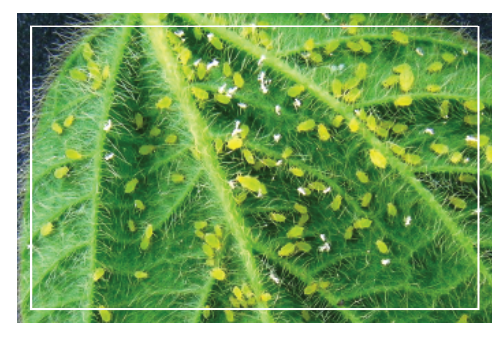John Gavloski, Entomologist, Manitoba Agriculture and Resource Development – Summer (June) 2021 Pulse Beat
 WITH ANY INSECT, pathogen or weed, repeated exposures to the same chemical will eventually lead to some individuals developing resistance to the chemical. Over time these can become the dominant portion of the population, reducing the effectiveness of the chemical. Resistance can be defined as a genetically based decrease in susceptibility to a pesticide. Insecticide resistance is common with aphids, which reproduce quickly and can have many generations within a year.
WITH ANY INSECT, pathogen or weed, repeated exposures to the same chemical will eventually lead to some individuals developing resistance to the chemical. Over time these can become the dominant portion of the population, reducing the effectiveness of the chemical. Resistance can be defined as a genetically based decrease in susceptibility to a pesticide. Insecticide resistance is common with aphids, which reproduce quickly and can have many generations within a year.
In 2015 in Minnesota, failures of foliar-applied pyrethroid insecticides against soybean aphids were reported and pyrethroid resistance was confirmed with laboratory bioassays. Research conducted in several northcentral U.S. states and Manitoba in 2017 confirmed resistance to pyrethroids in soybean aphid from Manitoba, Minnesota, North Dakota, South Dakota and Iowa.
WHERE WOULD THIS RESISTANCE HAVE COME FROM?
Soybean aphids are not an annual insect concern in Manitoba. Since soybean aphid was first found in Manitoba in 2001, there have been four years where there were more widespread insecticide applications (2006, 2008, 2011, 2017), and two years where there was some localized insecticide applications (2014 and 2015). Would this have been enough to build up insecticide resistance in Manitoba?
Soybean aphids do not overwinter well in the more northern areas of their range, and it is likely that populations of soybean aphids establishing in Manitoba have blown in from areas further south. If people are making annual insecticide applications for soybean aphids in some areas, and aphids from these populations are being blown into other areas, the areas the aphids arrive in could inherit problems developed in the source areas. I suspect that the pyrethroid-resistant soybean aphids detected in Manitoba in 2017 were not a problem that developed here, but that pyrethroid-resistant soybean aphids were part of the population that blew in that year. Regardless, there are lessons that can be learned and recommendations that are essential to keep insecticides working well for when they are truly needed.
MANAGEMENT STRATEGIES FOR MINIMIZING THE RISK OF RESISTANCE
In response to the challenge posed by insecticide-resistant soybean aphids, the entomologists studying these resistant aphids encourage growers, consultants and applicators to evaluate their soybean aphid management practices carefully. They also recommend several management strategies for minimizing further development of resistance and subsequent pest-induced crop losses:
- Scout and use the economic threshold to determine when to apply insecticides. Treating fields only when needed will reduce the selection pressure for further development of resistance. Fields should be scouted on a regular schedule (every seven to 10 days). The economic threshold is when there are at least 250 aphids per plant, the population is increasing and plants are in the beginning bloom (R1) to beginning seed (R5) growth stages. Treat within five to seven days of exceeding the economic threshold to protect yield. Tank mixing insecticide with herbicide applications regardless of pest populations is a practice that is best avoided, as it can result in multiple problems developing.
- If a field exceeds the threshold, make sure the insecticide is applied correctly. Use a rate recommended on the label. Applying insecticides below the labelled rate is not recommended. Use proper nozzles, spray volume and pressure, and spray under favourable conditions.
- After applications, scout fields again after three to five days to ensure the product provided the level of management expected.
- Alternate to a different insecticide group if another application is required. Before assuming resistance, try to rule out other potential causes for an insecticide failure (such as incorrect rate or application method or unfavourable environmental conditions). The Guide to Crop Protection can be used to determine registered insecticides for soybean aphids and what chemical group they belong to. Insecticide rotation needs to be done between different chemical groups; choosing a different insecticide in the same group is not considered a proper insecticide rotation.
In the long term, soybean aphid management must move beyond insecticide-based management to true integrated pest management by incorporating multiple tactics. An app called Aphid Advisor incorporated levels of six natural enemies of soybean aphids counted on 10 randomly selected soybean plants into the decision-making process. Using this app can help determine if the natural enemies present will likely be capable of maintaining the soybean aphids below economically damaging levels. We now have some selective insecticides registered to control soybean aphids, which kill aphids but not their natural enemies. Use of such products, should an insecticide application be necessary, will preserve biological controls that will help prevent any flare-ups of aphid populations, plus control other potential pests of soybeans. Wise use of insecticides will enable you to manage crop feeding insects when economically damaging levels exist, while reducing the risk of resistance developing and help maintain the many beneficial insects that help maximize yields and profits.
